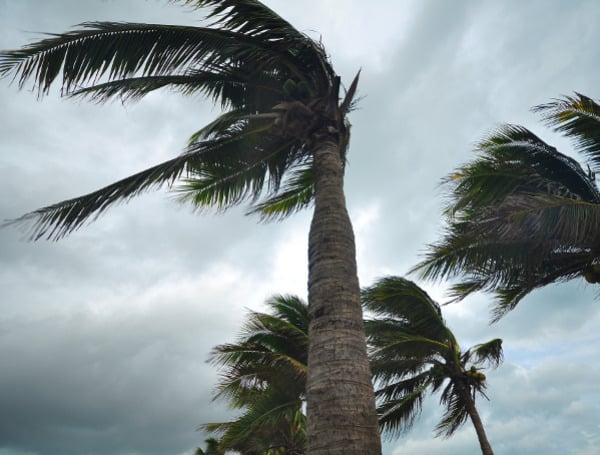This year’s hurricane season is most likely to affect the Gulf Coast, as experts anticipate a “hyperactive” tropical storm season.
According to Colorado State University and Tropical Storm Risk (TSR), which both release spring projections for the number of named storms and hurricanes each year, the 2024 Atlantic hurricane season will include 11 storms.
According to CSU, this year already shows signs of resembling 2020 and 2010, which saw 14 and 12 hurricanes.
Read: ‘Very, Very Busy’ Hurricane Season Eyed In Florida
Philip Klotzbach, a senior research scientist in the university’s Department of Atmospheric Science, said the forecast for a “very, very busy hurricane season” is based on expected La Niña conditions in the summer, resulting in hurricane-favorable wind shear conditions and warm water.
“If you look at the current sea-surface temperatures in the tropical Atlantic, and you say, ‘OK, we’re going to warm at the slowest rate that we’ve warmed between now and the peak of the season,’ you’re still talking water temperatures that are like top-five warm,” Klotzbach said. “So, unfortunately, I think there’s at least a little bit of, somewhat, the die is cast for 2024.”
Are you prepared?
With the Atlantic hurricane season lasting from June 1st to November 30th, it’s essential for residents to be well-prepared.
In this comprehensive guide, we will walk you through the steps to effectively prepare for hurricane season in Florida.
From understanding hurricane hazards to creating an emergency plan and assembling a hurricane kit, we’ve got you covered.
Understanding Hurricane Hazards
Before we delve into the preparations, it’s crucial to understand the hazards associated with hurricanes. Tropical storms, characterized by winds ranging from 39 to 73 mph, can quickly escalate into hurricanes with winds exceeding 74 mph. The upper right quadrant of the storm, known as the eye wall, is typically the most intense and dangerous part, with strong winds and heavy precipitation. In addition to high winds, hurricanes can also bring storm surges and heavy rainfall leading to flooding.
Creating an Emergency Plan
Preparing for a hurricane involves more than just deciding where to go. It’s essential to have a well-thought-out emergency plan in place for your family and property. Here are some key steps to consider:
Consult with Professionals
Before the hurricane season begins, consult with your physician and medical supply vendors to ensure you have an adequate supply of medication and necessary medical equipment. This is particularly important for individuals with chronic illnesses or special healthcare needs.
Identify Evacuation Routes and Shelters
Research and identify the nearest evacuation routes and public shelters in your area. If you need to evacuate, determine where you will go, whether it’s a relative’s house or a designated public shelter. Keep in mind that pets may not be allowed in some shelters, so make arrangements for your furry friends in advance.
Prepare Your Home
Take necessary precautions to secure your home and minimize potential damage. Cover windows with hurricane shutters or plywood. Trim trees and shrubs to prevent them from becoming hazardous projectiles during high winds. Reinforce your garage doors, and bring in outdoor furniture and other loose items that could be blown away or cause damage.
Gather Essential Supplies
Create a detailed list of essential supplies you will need during and after the storm. This includes non-perishable food, bottled water, a first-aid kit, flashlights, batteries, a battery-operated radio, and a waterproof container for important documents. Don’t forget to include special items for babies, older adults, and pets.
Stay Informed
Stay updated on the latest weather forecasts and evacuation orders issued by local authorities. Sign up for emergency alerts and have a battery-powered or hand-cranked radio on hand to receive updates in case of power outages. Follow the instructions of officials and evacuate immediately if advised to do so.
Assembling a Hurricane Kit
A well-prepared hurricane kit can make all the difference during a storm. Here’s a list of essential items to include in your kit:
Food and Water
Stock up on non-perishable food items that can last at least three to seven days. This includes canned goods, dry snacks, and food for infants or individuals with dietary restrictions. Ensure you have at least one gallon of water per person per day for drinking and sanitation purposes.
First-Aid Supplies and Medications
Prepare a comprehensive first-aid kit that includes bandages, antiseptic ointments, pain relievers, and any prescription medications you or your family members may need. Check expiration dates and restock as necessary. It’s also a good idea to have a detailed list of medications with dosage instructions.
Communication and Lighting
Include battery-powered flashlights, lanterns, and extra batteries in your hurricane kit. A battery-operated or hand-cranked radio will help you stay informed about the latest updates and emergency instructions. Keep a waterproof container with cash and important documents such as identification, insurance papers, and medical records.
Personal Hygiene and Sanitation
Pack personal hygiene items such as toilet paper, hand sanitizer, wet wipes, and feminine hygiene products. Include disposable plates, cups, and utensils for easy cleanup. Don’t forget to have a supply of garbage bags for waste disposal.
Clothing and Bedding
Pack a change of clothes for each family member, including sturdy shoes and rain gear. Prepare blankets, pillows, and sleeping bags to ensure comfort if you need to evacuate to a shelter or if your home loses power.
Entertainment and Comfort
To keep spirits high during the storm, include books, board games, playing cards, and other forms of entertainment for both children and adults. Consider comfort items such as stuffed animals or favorite blankets for young children.
Special Needs and Pet Supplies
If you have infants, elderly family members, or individuals with special needs, make sure to include necessary supplies such as formula, diapers, prescription medications, and medical equipment. For pets, pack food, water, medications, leashes, and identification tags.
Remember to periodically check and restock your hurricane kit throughout the season, ensuring that all items are in good condition and not expired.
Securing Your Home
Securing your home is crucial to minimize damage during a hurricane. Here are some measures you can take:
Window Protection
Cover all windows with hurricane shutters or plywood. Alternatively, consider installing impact-resistant windows or laminated glass. Avoid using tape on windows as it does not prevent them from breaking and can create dangerous shards of glass.
Roof Reinforcement
If possible, secure straps or clips to fasten your roof to the structure of your home. Reinforce any weak spots or areas prone to damage. Regular roof inspections and maintenance can help identify potential vulnerabilities.
Yard Maintenance
Ensure trees and shrubs are properly trimmed and free from dead branches that could become projectiles during high winds. Clean out rain gutters and downspouts to prevent clogging and water damage.
Garage Doors
Strengthen your garage doors to withstand strong winds. Consider installing a hurricane-resistant garage door or reinforcing existing doors with braces or impact-resistant panels.
Secure Outdoor Items
Bring in all outdoor furniture, decorations, and other items that could be picked up by strong winds. Anchor or store items that cannot be moved indoors to prevent them from causing damage or becoming projectiles.
Internal Door Preparations
Close, secure, and brace internal doors during the storm. This can help prevent drafts, minimize damage, and improve overall safety. Avoid using tape on internal doors, as it may cause damage upon removal.
Power Outages: Tips and Considerations
Power outages are common during severe storms. Here are some tips to help you cope with power loss:
Fuel and Cash
Fill your vehicle’s gas tank well in advance of the storm. Gas stations may run out of fuel or become inaccessible during the event. Additionally, have extra cash on hand as ATMs may not be operational during power outages.
Cell Phone Usage
Charge your cell phone fully before the storm and limit its use to conserve battery life. Consider investing in a portable charger or power bank for extended periods without electricity.
Temperature Control
During power outages, maintaining a comfortable indoor temperature can be challenging. Minimize heat gain by covering windows with blankets or towels and keeping doors closed. Avoid using fans unless necessary, as they can increase perceived temperature without actually cooling the room.
Water Supply
Fill your bathtub and large containers with water for essential needs such as flushing toilets and basic hygiene. Use water sparingly and consider investing in water purification tablets or filters for additional drinking water sources.
Food Safety
Adjust the temperature of your refrigerator and freezer to their coldest settings before the storm. This will help food stay fresh for longer in the event of a power outage. Avoid opening the refrigerator or freezer unnecessarily to preserve cold temperatures. Follow food safety guidelines and discard perishable items if they have been exposed to unsafe temperatures for an extended period.
Health and Safety
Be cautious of potential hazards during power outages. Use flashlights instead of candles to avoid the risk of fire. If using a generator, follow safety guidelines to prevent carbon monoxide poisoning. Keep emergency contact numbers accessible and be aware of local emergency services.
Help support the Tampa Free Press by making any small donation by clicking here.
Android Users, Click To Download The Tampa Free Press App And Never Miss A Story. Follow Us On Facebook and Twitter. Sign up for our free newsletter.


